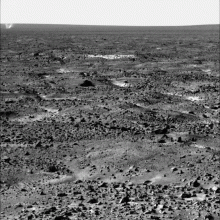Phoenix Lander Sees, Feels Martian Whirlwinds in Action

(PhysOrg.com) -- NASA's Phoenix Mars Lander has photographed several dust devils dancing across the arctic plain this week and sensed a dip in air pressure as one passed near the lander.
These dust-lofting whirlwinds had been expected in the area, but none had been detected in earlier Phoenix images.
The Surface Stereo Imager camera on Phoenix took 29 images of the western and southwestern horizon on Sept. 8, during mid-day hours of the lander's 104th Martian day. The next day, after the images had been transmitted to Earth, the Phoenix science team noticed a dust devil right away.
"It was a surprise to have a dust devil so visible that it stood with just the normal processing we do," said Mark Lemmon of Texas A&M University, College Station, lead scientist for the stereo camera. "Once we saw a couple that way, we did some additional processing and found there are dust devils in 12 of the images."
At least six different dust devils appear in the images, some of them in more than one image. They range in diameter from about 2 meters (7 feet) to about 5 meters (16 feet).
"It will be very interesting to watch over the next days and weeks to see if there are lots of dust devils or if this was an isolated event," Lemmon said.
The Phoenix team is not worried about any damage to the spacecraft from these swirling winds. "With the thin atmosphere on Mars, the wind loads we might experience from dust devil winds are well within the design of the vehicle," said Ed Sedivy, Phoenix program manager at Lockheed Martin Space Systems Company, Denver, which made the spacecraft. "The lander is very rigid with the exception of the solar arrays, which once deployed, latched into position and became a tension structure."
Phoenix monitors air pressure every day, and on the same day the camera saw dust devils, the pressure meter recorded a sharper dip than ever before. The change was still less than the daily change in air pressure from daytime to nighttime, but over a much shorter time.
"Throughout the mission, we have been detecting vortex structures that lower the pressure for 20 to 30 seconds during the middle part of the day," said Peter Taylor of York University, Toronto, Canada, a member of the Phoenix science team. "In the last few weeks, we've seen the intensity increasing, and now these vortices appear to have become strong enough to pick up dust."
A key factor in the whirlwinds getting stronger is an increase in the difference between daytime and nighttime temperatures. Daytime highs at the Phoenix site are still about minus 30 Celsius (minus 22 Fahrenheit), but nighttime lows have been dropping a few degrees, getting close to minus 90 Celsius (minus 130 Fahrenheit).
The same day as the dust devils were seen, the photographed swinging of Phoenix's telltale wind gauge indicated wind speeds exceeding 5 meters per second (11 miles per hour).
Images from spacecraft orbiting Mars had previously indicated that dust devils exist in the region where Phoenix landed.
"We expected dust devils, but we are not sure how frequently," said Phoenix Project Scientist Leslie Tamppari of NASA's Jet Propulsion Laboratory, Pasadena, Calif. "It could be they are rare and Phoenix got lucky. We'll keep looking for dust devils at the Phoenix site to see if they are common or not."
The dust devils that Phoenix has observed so far are much smaller than dust devils that NASA's Mars Exploration Rover Spirit has photographed much closer to the equator.
Provided by NASA





















